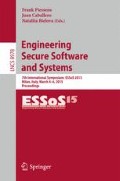Abstract
Many security-sensitive programs manage resources on behalf of mutually distrusting clients. To control access to resources, authorization hooks are placed before operations on those resources. Manual hook placements by programmers are often incomplete or incorrect, leading to insecure programs. We advocate an approach that automatically identifies the set of locations to place authorization hooks that mediates all security-sensitive operations in order to enforce expected access control policies at deployment. However, one challenge is that programmers often want to minimize the effort of writing such policies. As a result, they may remove authorization hooks that they believe are unnecessary, but they may remove too many hooks, preventing the enforcement of some desirable access control policies.
In this paper, we propose algorithms that automatically compute a minimal authorization hook placement that satisfies constraints that describe desirable access control policies. These authorization constraints reduce the space of enforceable access control policies; i.e., those policies that can be enforced given a hook placement that satisfies the constraints. We have built a tool that implements this authorization hook placement method, demonstrating how programmers can produce authorization hooks for real-world programs and leverage policy goal-specific constraint selectors to automatically identify many authorization constraints. Our experiments show that our technique reduces manual programmer effort by as much as 58% and produces placements that reduce the amount of policy specification by as much as 30%.
Access this chapter
Tax calculation will be finalised at checkout
Purchases are for personal use only
Preview
Unable to display preview. Download preview PDF.
References
F.38. sepgsql (2013), http://www.postgresql.org/docs/9.1/static/sepgsql.html
Anderson, J.P.: Computer security technology planning study, volume II. Technical Report ESD-TR-73-51, HQ Electronics Systems Division (AFSC) (October 1972)
Bell, D.E., LaPadula, L.J.: Secure computer system: Unified exposition and Multics interpretation. Technical Report ESD-TR-75-306, HQ Electronic Systems Division (AFSC) (March 1976)
Carter, J.: Using GConf as an Example of How to Create an Userspace Object Manager. In: 2007 SELinux Symposium (2007)
Walsh, D.: Selinux/apache, http://fedoraproject.org/wiki/SELinux/apache
Edwards, A., Jaeger, T., Zhang, X.: Runtime verification of authorization hook placement for the Linux security modules framework. In: Proceedings of the 9th ACM Conference on Computer and Communications Security, pp. 225–234 (2002)
Ganapathy, V., Jaeger, T., Jha, S.: Automatic placement of authorization hooks in the Linux Security Modules framework. In: Proceedings of the 12th ACM Conference on Computer and Communications Security, pp. 330–339 ( November 2005)
Ganapathy, V., Jaeger, T., Jha, S.: Retrofitting legacy code for authorization policy enforcement. In: Proceedings of the 2006 IEEE Symposium on Security and Privacy, pp. 214–229 (May 2006)
Ganapathy, V., King, D., Jaeger, T., Jha, S.: Mining security-sensitive operations in legacy code using concept analysis. In: Proceedings of the 29th International Conference on Software Engineering (ICSE) (May 2007)
Gong, L., Schemers, R.: Implementing protection domains in the javatm development kit 1.2. In: NDSS (1998)
Love, R.: Get on the D-BUS (January 2005), http://www.linuxjournal.com/article/7744
Multilevel security in the department of defense: The basics (1995), http://nsi.org/Library/Compsec/sec0.html
Muthukumaran, D., Jaeger, T., Ganapathy, V.: Leveraging “choice” to automate authorization hook placement. In: CCS 2012: Proceedings of the 19th ACM Conference on Computer and Communications Security, page TBD. ACM Press (October 2012)
Necula, G.C., McPeak, S., Rahul, S.P., Weimer, W.: Cil: Intermediate language and tools for analysis and transformation of c programs. In: Nigel Horspool, R. (ed.) CC 2002. LNCS, vol. 2304, pp. 213–228. Springer, Heidelberg (2002)
Politz, J.G., Eliopoulos, S.A., Guha, A., Krishnamurthi, S.: Adsafety: type-based verification of javascript sandboxing. In: Proceedings of the 20th USENIX Conference on Security, SEC 2011, p. 12. USENIX Association (2011)
SE-PostgreSQL? (2009), http://archives.postgresql.org/message-id/20090718160600.GE5172@fetter.org
Son, S., McKinley, K.S., Shmatikov, V.: Rolecast: finding missing security checks when you do not know what checks are. In: Proceedings of the 2011 ACM International Conference on Object Oriented Programming Systems Languages and Applications, OOPSLA 2011, pp. 1069–1084. ACM (2011)
Sun, F., Xu, L., Su, Z.: Static detection of access control vulnerabilities in web applications. In: Proceedings of the 20th USENIX Conference on Security, SEC 2011, p. 11. USENIX Association (2011)
Tan, L., Zhang, X., Ma, X., Xiong, W., Zhou, Y.: Autoises: automatically inferring security specifications and detecting violations. In: Proceedings of the 17th Conference on Security Symposium, pp. 379–394. USENIX Association (2008)
Implement keyboard and event security in X using XACE (2006), https://dev.laptop.org/ticket/260
Implement keyboard and event security in X using XACE (2006), https://dev.laptop.org/ticket/260
Xorg-Server Announcement (2008), http://lists.x.org/archives/xorg-announce/2008-March/000458.html
Zhang, X., Edwards, A., Jaeger, T.: Using CQUAL for static analysis of authorization hook placement. In: Proceedings of the 11th USENIX Security Symposium, pp. 33–48 (August 2002)
Author information
Authors and Affiliations
Editor information
Editors and Affiliations
Rights and permissions
Copyright information
© 2015 Springer International Publishing Switzerland
About this paper
Cite this paper
Muthukumaran, D., Talele, N., Jaeger, T., Tan, G. (2015). Producing Hook Placements to Enforce Expected Access Control Policies. In: Piessens, F., Caballero, J., Bielova, N. (eds) Engineering Secure Software and Systems. ESSoS 2015. Lecture Notes in Computer Science, vol 8978. Springer, Cham. https://doi.org/10.1007/978-3-319-15618-7_14
Download citation
DOI: https://doi.org/10.1007/978-3-319-15618-7_14
Publisher Name: Springer, Cham
Print ISBN: 978-3-319-15617-0
Online ISBN: 978-3-319-15618-7
eBook Packages: Computer ScienceComputer Science (R0)

